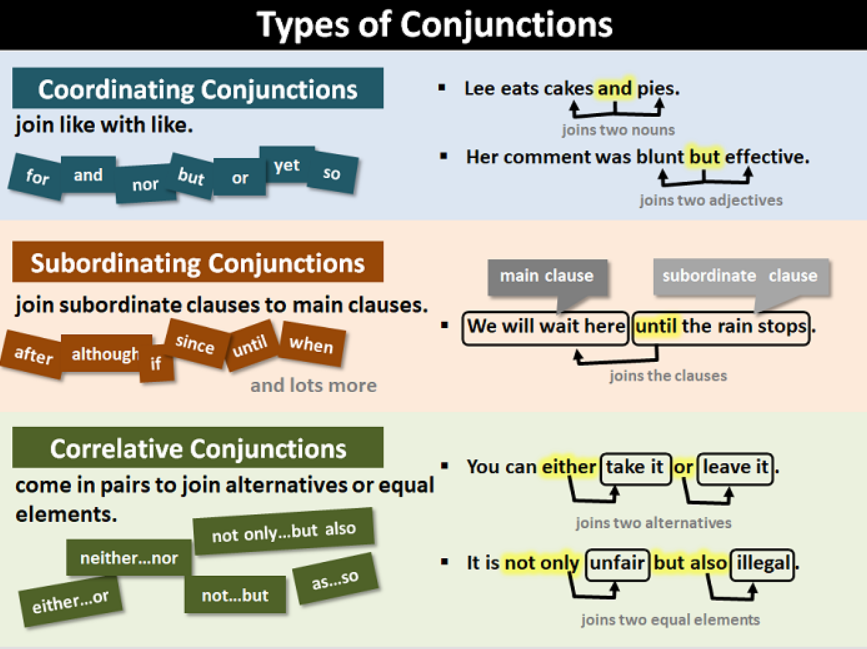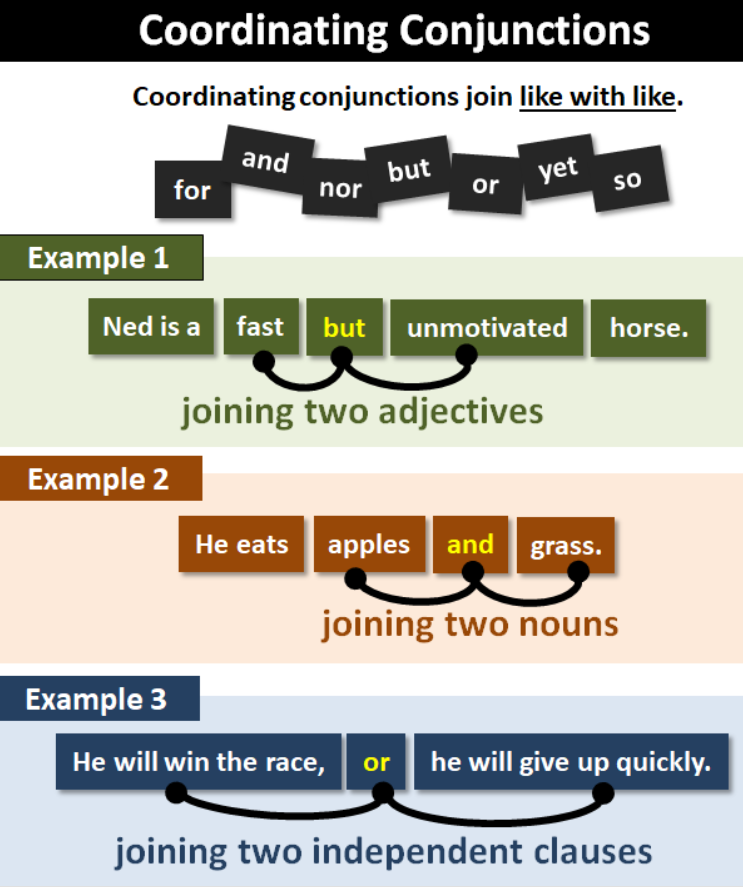Remember when writing a sentence was as simple as having a subject and a verb? But then school happened and suddenly, you’re learning about complex things like conjunctions. But what is a conjunction exactly?
In English class, we learned what are the eight parts of speech — and conjunctions are part of that group.
Conjunctions are words that connect phrases and clauses in a sentence. They are the glue that holds thoughts together.
There are three main types of conjunctions — coordinating, subordinating, and correlative — and we’ll explore each one of them in this blog post.
By the time you finish reading this article, those confusing terms won’t be a mystery anymore.
Let’s get started.
Table Of Contents:
- What is a Conjunction?
- Types of Conjunctions
- Coordinating Conjunctions
- Subordinating Conjunctions
- Correlative Conjunctions
- Comma Errors and Rules
- Can I Start a Sentence with a Conjunction?
- Conclusion
What is a Conjunction?
Imagine you’re at the breakfast table, and you have two thoughts, “I want cereal” and “I need milk.”
Without a conjunction, these are just two separate clauses.
Adding the conjunction “and” will link these ideas into one smooth sentence:
“I want cereal and I need milk.”
This is what conjunctions do – they connect words or groups of words in sentences.
Types of Conjunctions
There are three main types of conjunctions: coordinating, subordinating, and correlative.
Coordinating Conjunctions
These are words that join equals. Think “and,” “but,” “or,” “nor,” “for,” “so,” and “yet.” They’re the squad leaders of balance, linking similar elements in a sentence.
Example: “I like coffee, but my friend prefers tea.”
Subordinating Conjunctions
These are words that connect unequal elements. They introduce dependent clauses and show the relationship between them and the independent clause.
Common subordinating conjunctions include “although,” “because,” “if,” “since,” “when,” and “while.”
Example: “Because it was raining, we stayed indoors.”
Correlative Conjunctions
These conjunctions work in pairs to emphasize equality or oppositeness. They include pairs like “either…or,” “neither…nor,” “both…and,” “not only…but also,” and “whether…or.”
Example: “She is not only smart but also funny.”
To help you differentiate the three: coordinating conjunctions keep things equal, subordinating conjunctions handle the power dynamics, and correlative conjunctions come in pairs for emphasis.

Source: Grammar Monster
Coordinating Conjunctions
The magic of coordinating conjunctions lies in their ability to connect words, phrases, and clauses that are of equal importance.
The easiest way to remember coordinating conjunctions is through the mnemonic device FANBOYS — for, and, nor, but, or, yet, and so.
Let’s break down each of the letters.
For: It’s not just about “for” indicating a reason. You can use it to explain, provide a cause, or even express purpose.
Example: “She studied hard, for she wanted to ace the exam.”
And: This little guy joins similar elements like words, phrases, or clauses.
Example: “She likes to read books and watch movies.”
Nor: It’s the negative counterpart to “or” and connects two negative alternatives.
Example: “He neither called nor texted.”
But: The master of contrast, “but” brings opposing ideas together.
Example: “She wanted to go to the party, but she had to finish her work.”
Or: This one presents options. Use it when you’re presenting alternatives.
Example: “You can have tea or coffee.”
Yet: It’s all about contradiction or surprise.
Example: “She studied hard, yet she didn’t perform well.”
So: This is the conclusion junction. Use it to show cause and effect.
Example: “She studied hard, so she aced the exam.”

Subordinating Conjunctions
Subordinating conjunctions connect two ideas within one sentence – quite like a bridge between dependent and independent clauses.
An independent clause can stand on its own; it doesn’t need another sentence to make sense.
A dependent clause, on the other hand, needs something else to create a meaningful sentence.
This is where subordinating conjunctions step in. They bridge these clauses together into one comprehensive thought.
Example: “Although she was tired after studying all night for her test at Walden University’s writing center, Jane Austen decided to go out for breakfast with her friend anyway.”
‘Although’ is the subordinating conjunction here, connecting two dependent clauses.

Correlative Conjunctions
If you’ve ever found yourself in a ‘this or that’ situation, then you’ve used a correlative conjunction.
These are pairs of words like “either / or,” “both / and,” and “neither / nor” that work together to connect ideas.
You see, pairs of conjunctions have this unique task where they create specific relationships between sentence elements.
Either / or is all about choices.
For example: “You can either have pancakes or waffles for breakfast.”
The ‘both/and’ combo is inclusive.
For example: “Both studying hard and understanding concepts will help students ace their tests.”
‘Neither/nor’ works just like ‘either/or’ but here we’re rejecting options rather than choosing one.
For example: “If neither pizza nor pasta tickles your fancy, maybe it’s time for some sushi.”
To make sense of these sentences, we need to remember that correlative conjunctions always come in pairs. They work together to balance words, phrases, or clauses which have the same grammatical structure.
Comma Errors and Rules
Proper sentence structuring is not only about joining phrases but also remembering to use commas correctly. Accurately inserting commas can have a huge impact on the comprehensibility of one’s prose.
Here are the basic rules for using commas with conjunctions:
Coordinating Conjunctions:
Use a comma before the conjunction when joining two independent clauses (complete sentences).
Example: “She loves reading, and he enjoys watching movies.”
No comma is needed when the independent clauses are short and closely related.
Example: “She studied hard and aced the exam.”
Subordinating Conjunctions:
Generally, no comma is used if the subordinating conjunction is in the middle of the sentence.
Example: “I will go to the store after I finish my work.”
Use a comma if the subordinating conjunction introduces the sentence.
Example: “After I finish my work, I will go to the store.”
Remember, these are guidelines, not strict rules. Sometimes, using a comma depends on the flow and emphasis you want in your writing.
Can I Start a Sentence with a Conjunction?
Absolutely! Starting a sentence with a conjunction adds a touch of informality and can be a great way to emphasize a point or create a conversational tone.
The long-held belief that beginning a statement with a conjunction is wrong has been passed down through generations. But there is no absolute rule against employing common pairings like ‘and,’ ‘but,’ or ‘either/or’ at the beginning of sentences. In fact, many skilled writers and grammar textbooks use conjunctions at the beginning of sentences to add rhythm and emphasis, making writing more compelling.
You can start a sentence with a coordinating conjunction.
Example: “But, I thought we were going to the movies.”
While it’s less common to start a sentence with a subordinating conjunction, it’s not a strict no-no.
Example: “Although, I don’t agree with him.”
Starting with a conjunction can be a stylistic choice, and it’s often effective in casual writing or dialogue. Just be mindful not to overdo it as too many conjunctions can lead to sentence fragments.
To put this guideline to the test, begin sentences with coordinating or subordinating conjunctions and observe how they connect ideas and add intrigue to your narrative flow.
Conclusion
By now, you should have a firm grasp of what is a conjunction. These tiny yet mighty words connect ideas and create more complex sentences.
You’ve learned about coordinating conjunctions – the FANBOYS that link equal parts of a sentence together. You’ve dived into subordinating ones too, those subtle connectors giving depth to your thoughts. And you now know how correlative pairs work in tandem to emphasize relationships between ideas.
AI tools like BrandWell are adept at using conjunctions in sentences, but these machines are trained to strictly follow traditional grammar rules. If you want to start your sentence with a ‘but’ or ‘and’, that’s totally fine despite what old-school rules say.
Conjunctions are vital tools for expressing our thoughts clearly and elegantly. So don’t fear them but use them wisely.